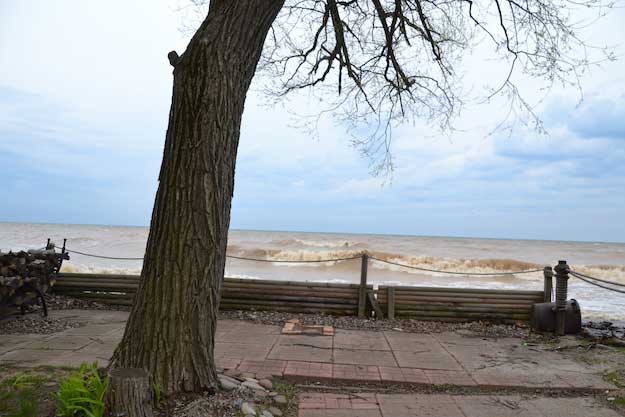Lake Ontario outflows set records in 2019 with further increases expected

Photo by Tom Rivers: Lake Ontario is pictured at the Green Harbor Campground in Carlton on May 16. The high waters and crashing waves caused damage along the southshore this year.
Press Release, International Lake Ontario – St. Lawrence River Board
Outflows will be increased substantially in the coming days as efforts to remove water from Lake Ontario continue.
Starting tomorrow, following the end of navigation season, outflows will be increased as much as possible until ice formation resumes on the St. Lawrence River. A flow increase from 8,850 m3/s (312,500 cfs) to over 10,000 m3/s (353,000 cfs) may be possible in the coming days, with the exact amount depending on ice and water level conditions in the St. Lawrence River.
Water levels downstream of the Moses-Saunders Dam, including around the Montreal area, are expected to rise, but will be monitored closely to ensure they are maintained below flood levels.
Lake Ontario outflows were first set to record-rates in June as water levels of Lake Ontario reached a new daily record-high of 75.92 m (249.08 ft). This followed an unprecedented spring that saw record water levels and flows occurring across the Great Lakes and Ottawa River basins.
High outflows from Lake Ontario continued through the summer, fall and early winter, resulting in more water released from Lake Ontario during the last seven months of 2019 than in any year since the start of records in 1900.
The average outflow from June through December was 9,560 m3/s (337,600 cfs), the highest flow ever released over this period, and equivalent to removing nearly 9.1 m (30 ft) of water from Lake Ontario during this time.
However, with all of the Great Lakes seeing record or near-record water levels in 2019, inflows to Lake Ontario have also remained high during that time. Lake Ontario’s level was 75.00 m (246.06 ft) yesterday and remains well-above seasonal averages. High inflows are expected to continue into 2020.
The International Lake Ontario – St. Lawrence River Board, under authority granted to it by the International Joint Commission, will continue to deviate from Plan 2014 and will look for any and all opportunities to remove additional water from Lake Ontario prior to the spring.
The first of these opportunities is expected at the start of January. Over the past several weeks, outflows were set at 200 m3/s (7,100 cfs) above the Plan 2014 maximum L-limit, which is the highest outflow that can be released from Lake Ontario, while still ensuring safe navigation through the St. Lawrence River. However, with the St. Lawrence Seaway season set to end on Dec. 31, this constraint will no longer apply.
Ice conditions are also no longer a constraint. Flows were temporarily reduced on Dec. 20 following a brief cold spell that resulted in temporary ice formation in the Beauharnois Canal. Mild temperatures followed, causing the ice cover to deteriorate and allowing outflows to again be rapidly increased. Ice formation will likely resume during the next cold spell, but the timing is uncertain.





































































